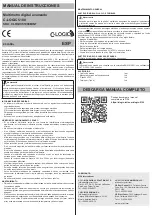
EN
7
multimeter BE47
Undefined displays
If measuring inputs are open or touched by hand, this can lead
to undefined displays. This is not a malfunction but a reaction of
the sensitive measuring input to existing interference voltages.
Normally, when there is no high interference level at the
workplace, and in case of a short circuit at the measuring input,
zero is displayed immediately. If the measuring object is
connected, the exact measured value is displayed. Fluctuations
in the displayed value by some digits are systemic and within
the tolerance.
If the resistance measuring range, the continuity testing range
or the diode test was selected and the measuring input is open,
the overflow indicator will appear.
Measuring DC voltage
Danger
Improper handling of the measuring device entails a
risk of electric shock!
Before carrying out voltage measurements, observe the
following:
•
Never apply a voltage exceeding the rated nominal voltage
of the measuring device between the connections, or
between the connections and ground (see imprint on
housing).
•
Check the measuring lines for damaged insulation and for
continuity. Exchange damaged measuring lines.
•
Check the insulation of the measuring device sockets.
•
Before using the measuring device check its functionality
by carrying out measurements with a known voltage.
•
First connect the measuring line connected to ground, and
only then connect the live measuring line. When
disconnecting the measuring lines, proceed in reverse
order, i.e. disconnect the live measuring line first.
•
Prior to every voltage measurement make sure that the
measuring device is not set to the current measuring
range.
•
If the device displays an overload (
OL
) immediately after
being connected to the measuring object, first switch off
the circuit at the measuring object and then immediately
remove the measuring lines from the measuring object.
•
Do not switch any motors in the measuring circuit on or off
during a measurement. Voltage peaks caused by switch-
on and switch-off can damage the measuring device.
1. Select the largest V DC voltage measuring range using the
rotary switch.
2. Insert the plug of the black measuring line into the COM
measuring socket and the plug of the red measuring line
into the V/Ω/mA measuring socket.
3. Connect both measuring tips to the measuring object with
correct polarity (black to minus, red to plus).
ð
If the input voltage is negative, a minus (-) will appear in
front of the measured value on the display.
ð
The measured value is shown on the display.
4. Turn the rotary switch to the position that is the closest to
the indicated value but does not fall below it.
ð
The measured value is shown on the display.
Measuring AC voltage
Danger
Improper handling of the measuring device entails a
risk of electric shock!
Before carrying out voltage measurements, observe the
following:
•
Never apply a voltage exceeding the rated nominal voltage
of the measuring device between the connections, or
between the connections and ground (see imprint on
housing).
•
Check the measuring lines for damaged insulation and for
continuity. Exchange damaged measuring lines.
•
Check the insulation of the measuring device sockets.
•
Before using the measuring device check its functionality
by carrying out measurements with a known voltage.
•
First connect the measuring line connected to ground, and
only then connect the live measuring line. When
disconnecting the measuring lines, proceed in reverse
order, i.e. disconnect the live measuring line first.
•
Prior to every voltage measurement make sure that the
measuring device is not set to the current measuring
range.
•
If the device displays an overload (
OL
) immediately after
being connected to the measuring object, first switch off
the circuit at the measuring object and then immediately
remove the measuring lines from the measuring object.
•
Do not switch any motors in the measuring circuit on or off
during a measurement. Voltage peaks caused by switch-
on and switch-off can damage the measuring device.
1. Select the desired V AC voltage measuring range using the
rotary switch.
2. Insert the plug of the black measuring line into the COM
measuring socket and the plug of the red measuring line
into the V/Ω/mA measuring socket.
3. Connect both measuring tips to the measuring object with
correct polarity (black to minus, red to plus).
ð
If the input voltage is negative, a minus (-) will appear in
front of the measured value on the display.
ð
The measured value is shown on the display.
4. Turn the rotary switch to the position that is the closest to
the indicated value but does not fall below it.
ð
The measured value is shown on the display.




























